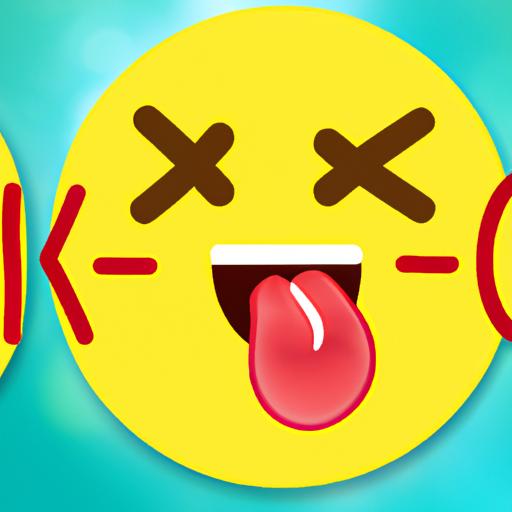Introduction

We all love to add a touch of wit and humor to our conversations, don’t we? Well, that’s where the tongue in cheek emoji comes into play! This quirky little symbol has become an essential part of our digital language, allowing us to express sarcasm, irony, or jest with just a simple click. In this article, we’ll explore the definition, significance, and fascinating history surrounding the tongue in cheek emoji, as well as its soaring popularity in the online world.
A. Definition and significance of tongue in cheek emoji
The tongue in cheek emoji, represented by a winking face with a tongue playfully poking out, has become a symbol of mischief and lightheartedness in our virtual conversations. It serves as a non-verbal cue, indicating that the statement being made is meant to be taken with a pinch of salt or a playful tone. This emoji allows us to infuse our messages with a dash of humor and adds depth to our digital expressions.
B. Brief history and popularity of tongue in cheek emoji
The journey of the tongue in cheek emoji began back in 2010 when it was first introduced as part of the Unicode Consortium’s Emoji 1.0 standard. Since then, it has gained immense popularity, finding its way into our everyday conversations across various messaging platforms and social media networks.
Why has it become so popular, you ask? Well, the tongue in cheek emoji provides a convenient way to convey sarcasm and irony in text-based communication, where tone and facial expressions are often lost. By using this playful symbol, we can ensure our words are interpreted as intended, evoking laughter or a cheeky grin from the recipient.
So, are you ready to dive deeper into the world of tongue in cheek emoji? Let’s uncover its hidden meanings, explore its usage, and discover how it has evolved over time. Get ready to unleash your playful side in the digital realm!
Meaning and Usage of Tongue in Cheek Emoji

A. Interpretation and symbolism behind the emoji
The tongue in cheek emoji holds a myriad of meanings and symbolism, making it a versatile tool for online expression. When we see this emoji, we immediately associate it with a playful or mischievous intent. Its winking face and protruding tongue symbolize a light-hearted and humorous approach to communication. It allows us to convey sarcasm, irony, or jest, adding a layer of depth and nuance to our digital interactions.
B. Common scenarios and contexts where it is used
Wondering when to employ the tongue in cheek emoji? Well, the possibilities are endless! This emoji thrives in scenarios where words alone may not adequately convey our intended meaning. It’s perfect for sarcastic remarks, witty banter, or teasing someone in a friendly manner. Whether you’re engaged in online debates, cracking jokes, or simply adding a touch of playfulness to a conversation, the tongue in cheek emoji is your go-to tool.
In social media interactions, you’ll spot this emoji accompanying clever captions or humorous comments, instantly signaling a light-hearted tone. It’s also popular in messaging platforms, where it helps avoid misunderstandings by indicating that a statement should be taken with a grain of salt. With the tongue in cheek emoji, you can engage in witty repartee, making your conversations more enjoyable and entertaining.
C. Examples of popular platforms using tongue in cheek emoji
The tongue in cheek emoji has become a staple across various platforms, embracing its playful nature. Social media giants like Instagram, Twitter, and Facebook have integrated this emoji into their vast collection of expressive symbols. It’s commonly used in comments, replies, and captions to add a dash of humor to posts and interactions.
Messaging apps such as WhatsApp, iMessage, and Slack also feature the tongue in cheek emoji, allowing users to infuse their conversations with light-heartedness and amusement. Whether you’re teasing a friend, sharing a witty comeback, or expressing irony, this emoji provides a visual cue that enhances the overall communication experience.
Now that we’ve explored the meaning and usage of the tongue in cheek emoji, let’s move on to the next section, where we’ll unravel the various ways to access this delightful symbol on different devices and platforms. Get ready to unleash your playful side with just a click of the tongue in cheek emoji!
How to Access Tongue in Cheek Emoji
A. Native support on different devices and operating systems
Wondering how to unleash the cheekiness of the tongue in cheek emoji on your favorite device? Well, you’re in luck! Most smartphones, tablets, and computers come equipped with native support for this playful symbol. Whether you’re an Android aficionado, an iOS enthusiast, or a Windows wizard, you’ll find the tongue in cheek emoji readily available in your device’s keyboard or emoji picker. Simply navigate to the appropriate section and let the mischief begin!
B. Alternative methods to access the emoji
But what if you’re using a device or operating system that doesn’t offer native support for the tongue in cheek emoji? Fear not, for there are alternative methods to get your hands on this mischievous symbol. One option is to use web-based platforms or messaging apps that provide a wide range of emojis, including the tongue in cheek emojJust open your preferred browser, head to the desired platform, and explore the vast collection of emojis at your disposal.
Another alternative is to use third-party emoji keyboards or apps that offer an extensive array of emojis beyond what’s available on your device’s default keyboard. These apps often allow you to customize your emoji selection, giving you access to the tongue in cheek emoji and many other expressive symbols to spice up your conversations.
C. Compatibility issues and workarounds
While the tongue in cheek emoji has become widely supported across various devices and operating systems, there may still be compatibility issues to watch out for. For instance, older devices or outdated software versions might not display the emoji correctly or at all. In such cases, it’s essential to ensure your device and software are up to date to avoid missing out on the playful charm of the tongue in cheek emoj
In rare situations where compatibility issues persist, there are workarounds available. One option is to copy and paste the emoji from a reliable source, such as a website or a text document, into your message. This method allows you to bypass any display or compatibility issues and ensure your intended playful message comes across loud and clear.
Now that you know how to access the tongue in cheek emoji, let’s delve into its fascinating evolution and uncover the hidden meanings behind this mischievous symbol. Get ready to take your online communication to a whole new level of playfulness!
Evolution of Tongue in Cheek Emoji
A. Changes in design and appearance over time
Just like fashion trends, emojis also go through their own style evolution. Over the years, the design and appearance of the tongue in cheek emoji have undergone subtle yet noteworthy changes. Initially, the emoji featured a simple winking face with a tongue sticking out. However, as technology advanced and emoji design became more standardized, the representation of this playful symbol received updates.
Today, you might come across variations in the design of the tongue in cheek emoji across different platforms and operating systems. Some platforms may feature a more detailed or animated version, while others may keep it minimalistic. These design modifications aim to enhance the user experience and ensure the emoji remains visually appealing and relatable.
B. Cultural influences shaping the emoji’s representation
Emojis are not only influenced by technological advancements but also by cultural contexts. The tongue in cheek emoji, despite being a universal symbol of playful banter, can carry different connotations based on cultural backgrounds and regional preferences. In some cultures, sticking out one’s tongue may be considered rude or disrespectful, while in others, it can signify jest or light-hearted teasing.
As emojis continue to bridge the gap between cultures, efforts are being made to create inclusive representations that cater to diverse audiences. Emoji designers take cultural sensitivities into account, ensuring that the tongue in cheek emoji is interpreted in a positive and humorous light across different societies.
C. Comparisons with similar emojis and their variations
Within the vast realm of emojis, you might come across similar symbols that share common themes or expressions. When it comes to tongue in cheek emoji, it can be interesting to compare and contrast them with other related emojis, such as the winking face emoji or the face with stuck-out tongue emoj
While the winking face emoji shares some similarities with the tongue in cheek emoji, it lacks the explicit playfulness conveyed by the tongue sticking out. On the other hand, the face with stuck-out tongue emoji presents a more exaggerated and mischievous expression, often used to indicate silliness or jest.
By comparing these emojis and their variations, we can appreciate the nuances in their meanings and usage, further enriching our digital communication with a wide range of playful options.
Conclusion
In a world where digital interactions dominate our lives, the tongue in cheek emoji has emerged as a powerful tool for injecting playfulness and humor into our online conversations. Its significance lies not only in its ability to convey sarcasm and irony but also in the emotional depth it adds to our messages. By using this cheeky symbol, we enhance engagement and create a more vibrant and expressive communication experience.
A. Recap of the importance and versatility of tongue in cheek emoji
Throughout this article, we’ve explored the definition and significance of the tongue in cheek emojWe’ve seen how it allows us to infuse our messages with wit and humor, making our online conversations more enjoyable and engaging. From sarcastic remarks to light-hearted banter, this emoji has become an essential part of our digital language.
B. Final thoughts on the future of tongue in cheek emoji usage
As we look ahead, it’s clear that the tongue in cheek emoji will continue to play a significant role in our online communication. Its popularity is only expected to grow, as more and more people embrace its playful nature and leverage its ability to convey nuanced emotions. In an increasingly digital world, this emoji bridges the gap between text-based conversations and face-to-face interactions, allowing us to express ourselves with greater depth and authenticity.
C. Encouragement to incorporate the emoji in online communication
So, why not join the fun? Whether you’re engaging with friends, colleagues, or even promoting your brand, incorporating the tongue in cheek emoji can bring a touch of whimsy and personality to your messages. Embrace the power of playful communication and let this emoji be your companion in expressing your thoughts and emotions.
Remember, at Emoji Play, we celebrate the joy and creativity that emojis bring to our digital lives. So go ahead, send that cheeky wink or playful tongue poke – and let the world know you’re ready to have some fun!
Emoji Play – Unleash the Power of Emojis in Your Digital Journey!










